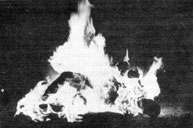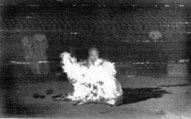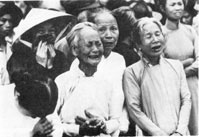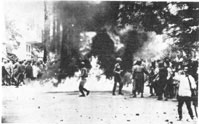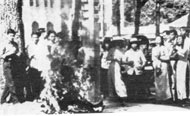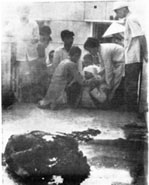Chapter 14
Religious Persecutions and Suicides by Fire
The gravity of Diem's policy of religious repression can best be judged if we remember that Christianity in Southeast Asia was a minority, and furthermore, that the Catholic Church was a minority of a minority. In Vietnam, out of a total population at that time of between 10 to 11 million peoples, only 1,500,000 were Roman Catholics. Of these, two thirds were refugees from the North, whereas the other Christians, mostly Baptists or Seventh Day Adventists, numbered approximately 50,000. The rest of the country was solidly Buddhist or professed religions derivatives from Buddhism. This meant that the Catholics made up a mere 12 to 13 percent of the whole of South Vietnam. The equivalent would be, as if a mere 12 to 13 per cent of Buddhists, or Hindus, or Moslems should attempt to terrorize the 230 million people of the U.S., the great bulk of whom are Christian.
His campaign of erosion and of direct and indirect elimination of the religious and political influence of Buddhism, of course, had run concurrently with the creation of a police state, and with the increasing acceleration of his Catholicization of the state, of the army and of the police force.
While so engaged, Diem's anti-Buddhist activities had been astutely kept in the background. This policy was justified, since, before dealing with the problem, he had first to strengthen his political and police apparatus. The spark was ignited when the sectarian volcano which had been simmering under the surface for some time finally burst out into the open on June 5, 1963. The Roman Catholics celebrated the day to honor Archbishop Ngo Dinh Thuc, Diem's brother. In their elation, they flew the flag of the Vatican at Hue, a predominately Buddhist city. There was no opposition or any violent protest on the part of the Buddhists.
Three days later, the whole of South Vietnam prepared itself to celebrate the 2,507th birthday of Buddha. The celebration centered in Hue, the center of Buddhist culture during more than 2,000 years. The Buddhists asked permission to fly the Buddhist flag. The Diem government's answer: a resounding No! When the day arrived, thousands of Buddhists protested the government's refusal. In addition Diem, two days before, had issued an ordinance which forbade the carrying of religious banners. The ordinance became known only after the Catholics had flown the Vatican's flag. Diem troops fired on the crowd and killed nine Buddhists. As a result of such blatant Catholic sectarianism, demonstrations took place all over South Vietnam. Buddhist leaders went to see Diem, asking for an end of such discrimination. Diem refused to pay indemnities for the victims, refused responsibility, and to cap it all, refused to punish those who had been responsible for the killings.
The Buddhist leaders, undeterred, gathered 400 monks and nuns, and on May 30 sat down for four hours before the National Assembly in the heart of Saigon. Then, since nothing happened, they declared a 48 hour hunger strike. The hunger strike spread elsewhere. After a token gesture during which he discharged three of his officials, Diem stated that the killings had been caused by—Communist agitators. The hunger strike spread to the general population, until over 10,000 individuals participated in Saigon alone. To add to the solemnity of the mass protest, the giant gong tolled incessantly from its principal tower, the gong of Xa Loi Pagoda. In the other Buddhist capital, Hue, the peaceful demonstration took a violent turn and fighting broke out. The violence was so unrestrained, that the main pagoda of Tu Dam was left almost in ruins.
The Buddhist tolerance finally gave way to concrete anger. A Buddhist crowd took the law into their own hands and burned to the ground a whole Catholic village next to Da Nang. In Hue, as violence recurred, the authorities imposed martial law. As a result, a Buddhist crowd, led by students, demonstrated before the house of government delegates who called in troops. Blister gas was used and over 77 individuals were hospitalized with blister burns.
More Buddhist demonstrations followed. All in vain. Finally, an elderly Buddhist monk, Superior Thich Quang Duc, sent a message to President Diem. The message: "enforce a policy of religious equality." Thereupon, having calmly sat down in a main street of Saigon, poured gasoline on himself and burned himself to death. It was June 2, 1963. The self-immolation caused enormous reaction within and outside South Vietnam. The world at large could not understand what was going on, the media having knowingly or unknowingly given muddled and contradictory reports about the true state of affairs. Diem, however, did not budge. Other Buddhist monks followed Thich Quang Duc's example. Within a brief period, six of them burned themselves to death as a protest.
Diem and most of his Catholic supporters were unimpressed. Indeed some of them even jested about the monks self immolation. Madame Nhu, Diem's sister-in-law, for instance, commented about the Buddhists "barbecuing" themselves. Buddhist demonstrations continued during the following month. On July 30, 30,000 participated in protests at Saigon and Hue. In the latter city, August 13, there was quite uncontrollable violence. Another young Buddhist monk, Thich Thanh Tuck, burned himself to death in the Phuc Duyen Pagoda, following the example of yet another, a few days before, Thich Mguyen Huong, who had done the same on August 4. Then on August.15, a woman, a Buddhist nun, Dieu Quang, immolated herself in the courtyard of the Tu Dam Pagoda.
Following such individual and mass Buddhist demonstrations, Diem finally took off the mask, promulgated a siege of the whole country by declaring a state of martial law. Diem's police were let loose. They occupied, sealed and plundered pagoda after pagoda in the capital, in Hue, Hkanhhoa, Da Nang and other towns. They put down demonstrations with the utmost brutality and beat many Buddhist monks. Finally an order was issued to close all the pagodas. The order was greeted with collective anger. Riots occurred. In the city of Hue alone, on August 21, no less than one hundred Buddhists were killed by Diem police, thirty of them Buddhist students.
The massacre was followed by mass arrests. Buddhist monks and nuns were detained by the thousands all over South Vietnam. Diem's agents shot at random or organized truncheon rampages against the Buddhist crowds. Special forces, under the aegis of Ago Dinh Nhu, arrested any Buddhist leaders they could find. Prominent Buddhists were tortured by special police. Pagodas were besieged. 200 students were arrested with another 6,000 individuals on August 25. Two days later, the 27th, 4,000 more were detained. On September 3, 5,600 pupils demonstrated at schools. On September 15, 6,000 more pupils demonstrated at Dalat, and in other places.
In early October, thousands of Buddhist students were arrested and tortured by Nhu's agents. Buddhist leaders went into hiding, one of the most prominent, Thich Tri Quang, seeking safety within the walls of the American Embassy itself. It is to the credit of many Americans in the civil and military administrations, that they expressed their horror at what they were witnessing with their own eyes. Most of them, although confused as to the basic issues of the religious-political conflict, nevertheless were highly shocked at the ruthlessness of the Diem regime. At Washington, the feelings were no less deep. There were recriminations and criticism. The South Vietnam religious persecutions were threatening the domestic peace within the U.S. itself. Besides, the rest of the world was beginning to take notice of the events by openly asking awkward questions as to the real objectives of the U.S. presence in Southeast Asia.
Finally the U.S. issued a declaration, " . . . it appears that the government of the Republic of Vietnam, has instituted serious repressive measures against the Vietnamese Buddhist leaders . . . The U.S. deplores repressive actions of this nature." Notwithstanding this, and the worldwide publicity, the media of America remained strangely silent about the whole issue. When they were forced to report the news of the religious persecutions of the Buddhists by the Catholic Diem, either they gave them the smallest coverage, or minimized the whole issue when not slanting the news altogether. The Catholic-CIA-Diem lobby saw to it that the whole picture became effectively blurred, lest the American people take action.
Buddhist monk, Thich Tieu, burns himself to death in the courtyard of the Tu Dam Pagoda. During the agony of a death by fire, his body is seen twisting in the flames. He committed suicide in protest against the anti-Buddhist laws enacted by Catholic President Diem. This took place in the sacred Buddhist city of Hue, South Vietnam on August 16, 1963. Before setting himself alight, the monk had announced over a loudspeaker that he was going to commit suicide before the pagoda itself, in support for the Buddhist demand for civil and religious rights denied them by Catholic President Diem. Having made the announcement, he then soaked his robes with gasoline and set himself on fire. It was the first self-immolation in protest against the Catholic persecution of the Buddhists in South Vietnam. The courage and self-sacrifice of the monk made a tremendous impression not only all over Vietnam but also in the rest of the outside world.
Immolation by fire of Buddhist monk, Nun Nu Thanh Quang, at the Dieu de Pagoda in Hue, May 31, 1963. The self-immolation by fire was the culmination of Buddhist protests against Catholic terrorization by Diem and his two brothers, the archbishop and the head of the secret police. Buddhist "dissenters" were arrested and summarily sent into concentration camps with no consideration for civil liberties or personal freedom. Between 1955 and 1960 at least 24,000 were wounded, while 80,000 people were executed or otherwise murdered, 275,000 had been detained or interrogated. Eventually about 500,000 were sent into concentration or detention camps. The Catholic state machinery of suppression became so overpowering and ruthless that the U.S. had to protest, privately and officially, the barefaced religious character of Diem's Catholic policy. Many more Buddhist monks followed the example of Nun Nu Thanh Quang in protest against Diem's Catholic regime. It took tremendous personal courage to prepare oneself for death by fire in order to uphold one's own religious belief. The self-immolation of Buddhist monks and nuns helped to revive the religiosity of millions of Buddhists, who became determined to resist the unjust laws of the Diem government. The Catholic Church never expressed any sorrow or admiration for these Buddhist martyrs.
Expressions of horror on the faces of sobbing Vietnamese women, watching the burning body of a Buddhist nun, who set herself on fire and died under the eyes of hundreds of horrified onlookers. The nun was consumed by fire in the courtyard of a pagoda in Saigon. She committed suicide as a protest against the anti-Buddhist laws being enforced by the South Vietnamese government. Monks and nuns preceded and followed her example. The self-sacrifice of such Buddhists helped to draw the attention of the Western world to the reality of the persecution being carried out against the Buddhists by the Catholic dominated regime of South Vietnam. Not only while President Diem was in charge, but even afterwards. Many Buddhists suffered imprisonment and were sent to detention camps for protesting against the discriminatory laws passed against them by the Catholic authorities.
Catholics fighting Buddhists in Saigon, the capital of South Vietnam. Catholic mobs attacked Buddhists when these reacted against the regulations, which forbade Buddhists from praying in and outside their pagodas. "Molotov cocktails" are exploding against unarmed troops, which were trying to separate the fighters. These were throwing stones and were using clubs. Similar riots occurred in other parts of the country, when President Diem enacted anti-Buddhist laws. The mobs in this picture are fighting outside a Catholic Church of the capital. Several Catholic buildings were attacked by the Buddhists, when Catholic Diem closed all Buddhist pagodas. The Catholics retaliated by attacking Buddhist buildings. The Diem police were very partial to the Catholics, since many of the special police were Catholics themselves and therefore, personally antagonistic to the Buddhists.
Suicide by fire before the Roman Catholic Cathedral of Saigon. Passersby are praying and many are weeping as a Buddhist monk burns himself to death before the Roman Catholic Cathedral of Saigon. These self-immolations demonstrate the intensity of the feelings against the injustice of the anti-Buddhist regulations and helped harden the Buddhist will to resist the Catholic persecution. The Buddhist monks and nuns insisted upon passive resistance and demonstrated their belief in nonviolent protest by dying for their principles. Others less patient started violent protests and riots against secret police and troops sent into the streets to tame the Buddhists who resisted Catholic harassment and persecution.
The horrific sight of a woman teacher burning herself to death before shocked onlookers. The teacher, half consumed by fire, is falling upon herself in twisted agony. Another Buddhist nun is wailing near her, supported by friends. This self-immolation occurred before a pagoda in Saigon, another example of the depth of despair created by Catholic Diem's persecution against the Buddhist population of South Vietnam. |
